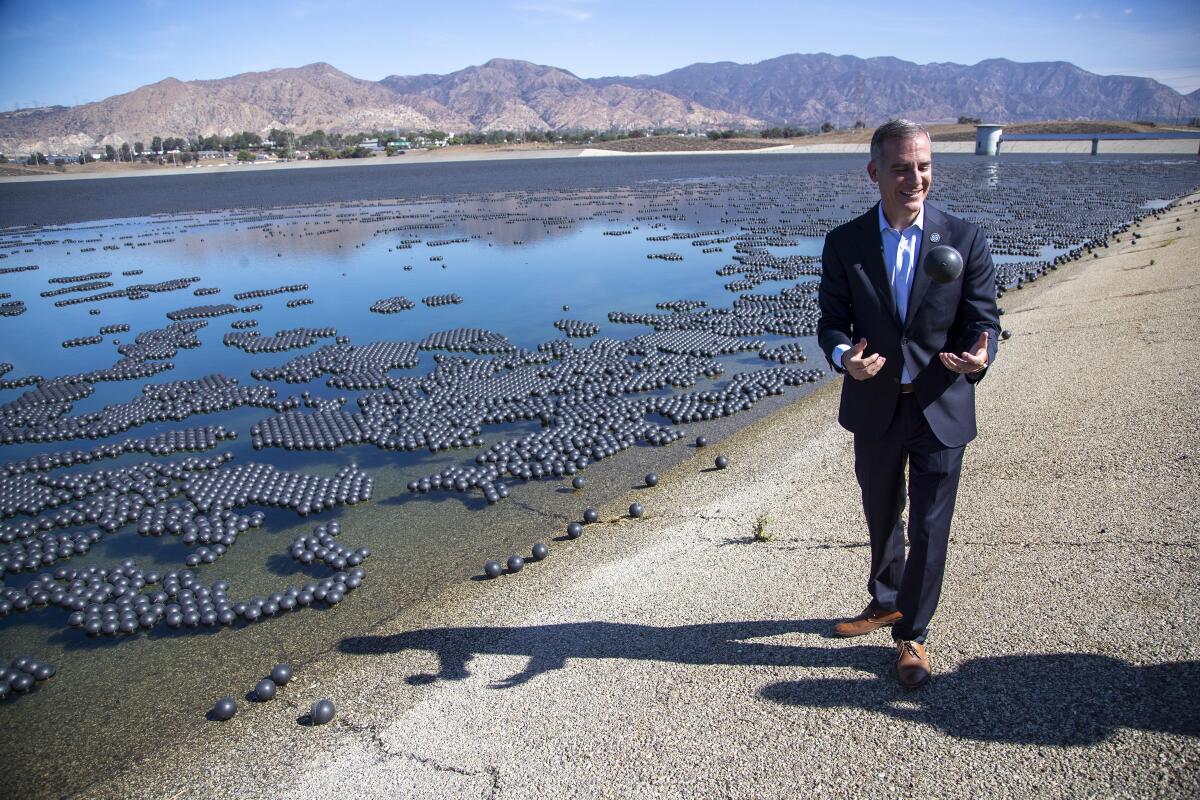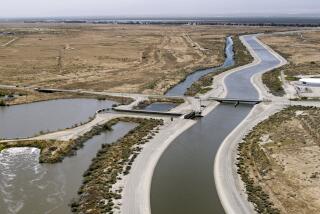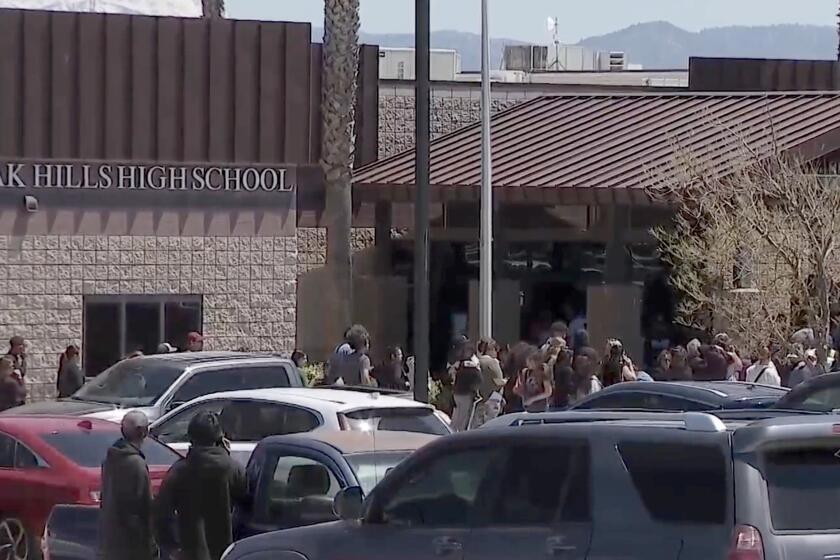Los Angeles shifts water supplies as drought hammers State Water Project

Cities in Southern California rely largely on water flowing through aqueducts from the Colorado River and the Sierra Nevada. But some parts of the region, such as Ventura County and northwestern L.A. County, don’t have access to Colorado River water and depend entirely on the water that comes from the Sierra through the State Water Project.
With the project’s supplies now severely limited due to the drought, Southern California’s water agencies have begun shifting these precious supplies to areas that need it most, while Los Angeles is taking less from the State Water Project and instead receiving Colorado River water to fill the gaps.
Los Angeles Mayor Eric Garcetti announced an agreement on Tuesday, saying the city’s Department of Water and Power is assisting the region by taking less water from the State Water Project, helping to preserve those supplies so that other districts will get the water. In turn, Los Angeles is receiving additional Colorado River water that has been stored by the Metropolitan Water District of Southern California.
“This partnership is about more than how we respond in a dry year — it’s about how we prepare our region for tomorrow,” Garcetti said.
Garcetti announced the city’s participation in shifting water supplies during a news conference at the Los Angeles Reservoir, standing beside officials from the MWD and other water agencies. They urged people across Southern California to redouble their conservation efforts and continue to reduce water use.
The shift in water supplies by the Metropolitan Water District is making an extra 20,000 acre-feet of water available from the State Water Project for communities that don’t have access to other supplies, and will make an additional 40,000 to 50,000 acre-feet available next year, said Gloria Gray, chairperson of the MWD board.
“That’s water that is available for 150,000 homes. That’s significant,” Gray said.
This year, with California’s largest reservoirs at some of their lowest levels ever, water agencies in Southern California received just 5% of their full allocations from the State Water Project.
“We’re expecting to start next year with a 0% allocation,” Gray said. “That means we need everyone throughout Southern California to look for ways to conserve water.”
The region’s water suppliers have managed through a very dry year, Gray said, thanks to shifts in operations, water stored in reserves and strides in conservation.
“But we’re facing unprecedented conditions in our Northern California reservoirs, and next year could be an even bigger challenge,” Gray said. “So we need everyone to work together to save water, particularly in communities that rely on the State Water Project.”
The Los Angeles Department of Water and Power receives a large portion of its water — this year a projected 72% of the city’s total water supplies — through the MWD from the State Water Project and the Colorado River, both of which are seeing shortages.
The State Water Project delivers water from the Sacramento-San Joaquin River Delta to farmlands and cities to the south. Built in the 1960s and early 70s, the project includes canals, pipelines, reservoirs and pumping facilities, which transport water to approximately 27 million Californians.
For now, California’s allotments of Colorado River water haven’t been cut back like those of Arizona and Nevada, but that could change as the water level of Lake Mead continues to decline toward more severe shortage levels.
Anselmo Collins, LADWP’s senior assistant general manager of the water system, pointed out that behind them, on the surface of the reservoir, were floating plastic shade balls. These balls were rolled into the reservoir by the thousands to ensure water quality, and they also reduce evaporation. Collins described the water-shifting agreement as another sort of collaborative innovation to safeguard water supplies.
Collins said MWD’s managers suggested shifting demands away from the State Water Project, and managers at LADWP readily agreed.
“We believe this is a great partnership. It helps everybody out,” Collins said. Working together in this way, he said, “we are able to strengthen our regional water supply.”
He added that Angelenos “should rest assured that this partnership with Metropolitan, it is not going to affect the reliability, the water quality or the cost-effectiveness of the water that we provide.”
Areas in Southern California that rely heavily or entirely on the State Water Project include northwestern L.A. County and Ventura County, parts of the San Gabriel Valley and parts of the Inland Empire. According to the MWD, 6.5 million people live in areas that are dependent on the State Water Project.
Shifting supplies in this way “helps preserve the limited state water supplies that are a lifeline to Ventura County,” said Steve Blois, president of Calleguas Municipal Water District’s board. “This persistent drought is dictating that we all must work together to explore the full capabilities of our water systems.”
Jay Lewitt, president of Las Virgenes Municipal Water District’s board, said his agency’s area in western L.A. County gets nearly all its water from the State Water Project.
“Our customers, who are doing a great job conserving, they need to be prepared to significantly reduce their water usage,” Lewitt said. “For our agency, nearly 70% of residential water use is for outdoor irrigation. This is where the biggest savings can be found.”
Gov. Gavin Newsom in July called for all Californians to voluntarily reduce water use by 15%.
Though California naturally undergoes swings between dry spells and deluges, higher temperatures brought on by climate change are making droughts more intense.
The snowpack this year in the northern Sierra Nevada, which feeds the state’s reservoirs, peaked at 72% of average in April, and then rapidly melted during the hottest spring on record. Extreme heat has baked much of the West and left the soils parched, which has soaked up a portion of the runoff and left diminished flows in rivers.
“Angelenos stepped up the last time we asked them to conserve water,” during the 2012-16 drought, Garcetti said. “We don’t know what next year holds, so we need to make water conservation a way of life.”
People in L.A. and other cities in the West have reduced water use significantly over the years, even as populations have grown. Water use in Los Angeles over the past five years was lower than in the 1970s, according to LADWP. Los Angeles now depends mostly on imported water, drawing an estimated 16% this year from local sources. But Garcetti has touted a goal of shifting to 70% local water sources by 2035.
MWD General Manager Adel Hagekhalil said collaboratively leveraging resources across Southern California will be essential now and in the years to come. He noted that MWD is working on a large project to recycle wastewater to help meet the region’s water needs.
Hagekhalil and the mayor stood side by side under a blue sky, a day after storms brought drenching rain and lit up the night skies with lightning.
“The rain yesterday is ... just a drop,” Hagekhalil said. “We need to continue doing the right thing — conserving, conserving and working hard together.”
More to Read
Start your day right
Sign up for Essential California for news, features and recommendations from the L.A. Times and beyond in your inbox six days a week.
You may occasionally receive promotional content from the Los Angeles Times.







